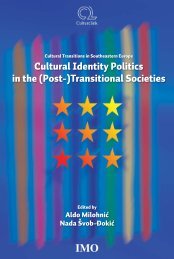D:\Documents and Settings\Ana\My Documents\Biserka-knjiga ...
D:\Documents and Settings\Ana\My Documents\Biserka-knjiga ...
D:\Documents and Settings\Ana\My Documents\Biserka-knjiga ...
You also want an ePaper? Increase the reach of your titles
YUMPU automatically turns print PDFs into web optimized ePapers that Google loves.
Digital Culture: The Changing Dynamics<br />
information always, <strong>and</strong> necessarily, refer to the essence of community <strong>and</strong> human<br />
relations” (Pasquali, 2003: 198). For Hamelink “information contents are cultural<br />
products. Information is a part of a society’s cultural fabric. Among the important<br />
issues of this dimension are the sharing of knowledge <strong>and</strong> the protection of cultural<br />
identity” (Hamelink, 2003: 124). Thus he claims that the ways in which societies deal<br />
with the provision <strong>and</strong> processing of information is determined by cultural<br />
perspectives. His underst<strong>and</strong>ing of the concept of communication is wider than just<br />
the transfer of messages <strong>and</strong> he states that to communicate “refers to a process of<br />
sharing, making common or creating a community” (Hamelink, 2003: 155). Cultural<br />
expressions, like language, are systems of signs for communication, <strong>and</strong> through<br />
common cultural codes people construct their underst<strong>and</strong>ing of their environment<br />
<strong>and</strong> create shared (thus common) meanings. James Carey also differentiates between<br />
two views of communication: the first one he calls “the transmission view of<br />
communication” whereby messages are transmitted <strong>and</strong> distributed in space for the<br />
control of distance <strong>and</strong> people; the other is “the ritual view of communication” i.e.<br />
representation of shared beliefs within a community. The transmission view is<br />
commonly defined by terms such as sending, transmitting or giving information to<br />
others, while the ritual view is directed not towards the extension of messages in<br />
space but towards the maintenance of society in time through the representation of<br />
shared beliefs (Carey, 1992). Communication as transmission represents the building<br />
blocks upon which communication as a ritual is based.<br />
So, when we talk about culture, communication is implicit. As Foresta tells us,<br />
“each society constantly recreates itself through communication by constantly<br />
redefining its collective reality, its culture” <strong>and</strong> “culture is a memory, collective<br />
memory, dependent on communication for its creation, extension, evolution <strong>and</strong><br />
preservation” (Foresta, Mergier, Serexhe, 1995: 19). Knowledge has always been<br />
communicated <strong>and</strong> embedded (thus preserved) through our cultural communication<br />
structures <strong>and</strong> available technologies have always been an important element that<br />
enabled <strong>and</strong> facilitated these processes of creating, sharing <strong>and</strong> preserving our<br />
cultural memory.<br />
Digital culture - new social ecology<br />
The claim that technology impacts different aspects of our culture is over-simplified<br />
<strong>and</strong> too deterministic, but it is not completely wrong. We are aware of the changes<br />
that happened in present-day societies that are related to introducing ICT into our<br />
lives in the same way as electricity in the past. We could say that all technologies<br />
intervene in the human environment <strong>and</strong> modify it to a certain extent, thus changing<br />
the conditions of existence of different cultures (in a more or less radical way). They<br />
make certain practices obsolete while some previously difficult <strong>and</strong> impractical<br />
10



